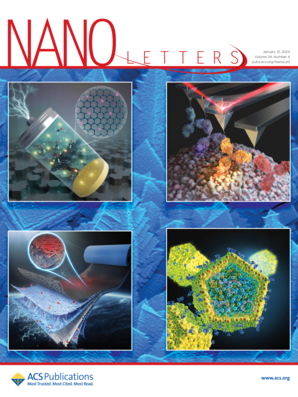Exploiting Spintronics at Room Temperature for Long-Wave Infrared Nanophotonic Digital Bolometers
IF 9.6
1区 材料科学
Q1 CHEMISTRY, MULTIDISCIPLINARY
引用次数: 0
Abstract
Digital detectors that “click” such as avalanche diodes and superconducting nanowire sensors are widely used in visible and near-infrared frequencies within the fields of quantum communications, imaging and metrology. On the other hand, the vast field of infrared bolometry has been dominated by analog detectors barring a few examples which require extremely challenging low temperature environments. Here, we propose and demonstrate a nanophotonic bolometer designed by engineering spintronic materials and dimensions to provide “clicks” from thermally activated transitions between two discrete magnetization states. We demonstrate that this nanophotonic bolometer is capable of high readout speeds of 91.6 MHz, which is faster than commercial vanadium dioxide detectors, and a noise equivalent temperature difference of ∼103 mK at 25 Hz. Further improvements to optical and thermal coupling are expected to push the sensitivity beyond even state-of-the-art cooled imagers paving the way for a new class of high-speed room temperature infrared sensors.

求助全文
约1分钟内获得全文
求助全文
来源期刊

Nano Letters
工程技术-材料科学:综合
CiteScore
16.80
自引率
2.80%
发文量
1182
审稿时长
1.4 months
期刊介绍:
Nano Letters serves as a dynamic platform for promptly disseminating original results in fundamental, applied, and emerging research across all facets of nanoscience and nanotechnology. A pivotal criterion for inclusion within Nano Letters is the convergence of at least two different areas or disciplines, ensuring a rich interdisciplinary scope. The journal is dedicated to fostering exploration in diverse areas, including:
- Experimental and theoretical findings on physical, chemical, and biological phenomena at the nanoscale
- Synthesis, characterization, and processing of organic, inorganic, polymer, and hybrid nanomaterials through physical, chemical, and biological methodologies
- Modeling and simulation of synthetic, assembly, and interaction processes
- Realization of integrated nanostructures and nano-engineered devices exhibiting advanced performance
- Applications of nanoscale materials in living and environmental systems
Nano Letters is committed to advancing and showcasing groundbreaking research that intersects various domains, fostering innovation and collaboration in the ever-evolving field of nanoscience and nanotechnology.
 求助内容:
求助内容: 应助结果提醒方式:
应助结果提醒方式:


